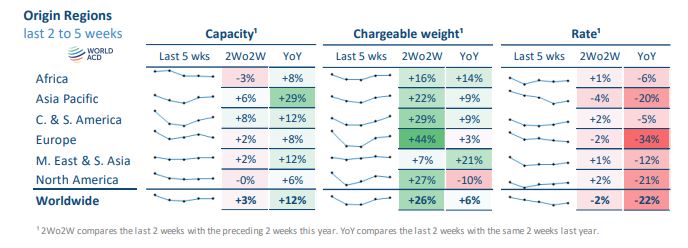January air cargo volumes “significantly up” on last year
26 / 01 / 2024

Photo: Jaromir Chalabala/ Shutterstock
Worldwide air cargo demand in January remains “significantly up” on a year ago with improvements across nearly all the main regions, according to the latest figures from data provider WorldACD.
Figures from the company show that in the two weeks running to January 21, air cargo demand levels are up 5% compared with the same period last year.
The improvements are across all major regions, with the exception of North America.
While demand continues to improve, airlines have also been busy adding aircraft back into service resulting in a 12% rise in capacity.
Rates, meanwhile, are down 22% at $2.35 per kg in light of the capacity additions and high rates this time last year. However, they are still 32% up on pre-Covid 2019.
WorldACD said that some of the increase in demand may reflect a switch to air or sea-air due to vessels diverting around the Cape of Good Hope as a result of attacks on ships passing through the Red Sea.
A 21% increase in tonnages ex-Middle East & South Asia may reflect some conversion of ocean freight to air and sea-air cargo due to the Red Sea disruptions.

Source: WorldACD
The timing of the Lunar New Year (LNY) holiday, which this year starts on February 10 rather than January 22, may also be playing a role in the increased volumes.
However, WorldACD said that from a data perspective, it was hard to separate out the potential Red Sea and LNY traffic from the normal seasonal mid-January uplift following the New Year slowdown.
“Reflecting the serious disruptions to international container shipping, ocean freight spot rates from Asia to Europe are now around three times their level prior to the Red Sea disruptions, although air cargo rates remain relatively stable globally, and ex-Asia Pacific, compared with before the Red Sea crisis – although ex-Asia Pacific air cargo rates had already risen in the final quarter of last year due to seasonal and product-related demand factors,” WorldACD said.
“Some forwarders say that in anticipation of ocean-to-air conversions, they are blocking additional air capacity on core trade lanes to help customers keep their freight moving.
“Others note that the window for booking airfreight ahead of Lunar New Year is closing and the next two to three weeks could be challenging, with the expectation of ‘bunched’ container ships arriving en masse at the main European ports, potentially triggering port delays, driver shortages and cargo build-ups at warehouses, driving further traffic towards air cargo.”













